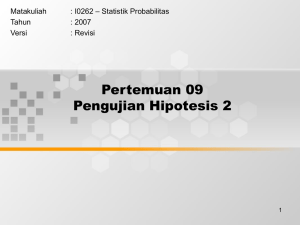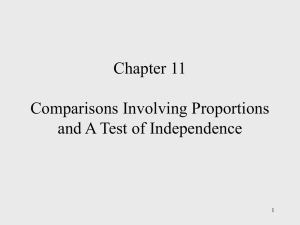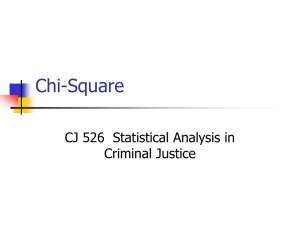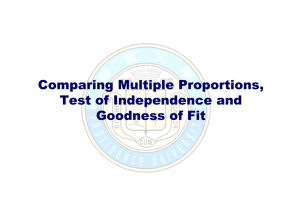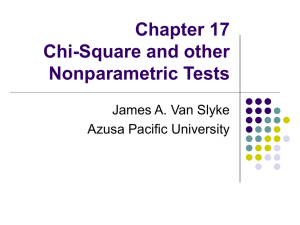Day 26 Goodness of Fit Test for Proportions of Multinomial Population
advertisement
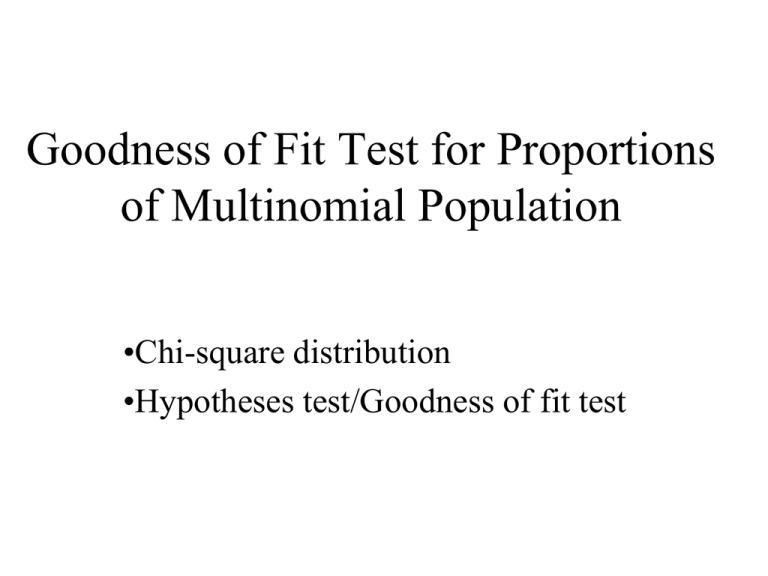
Goodness of Fit Test for Proportions of Multinomial Population •Chi-square distribution •Hypotheses test/Goodness of fit test Chi-square distribution With 2 degrees of freedom With 5 degrees of freedom With 10 degrees of freedom 2 0 Chi-Square Distribution a2 • We will use the notation to denote the value for the chi-square distribution that provides an area of a to the right of the stated a2 value. • For example, there is a .95 probability of obtaining a 2 (chi-square) value such that 2 .975 2 2 .025 For 9 d.f. and a = .975 Selected Values from the Chi-Square Distribution Table Area in Upper Tail Degrees of Freedom 5 6 7 8 9 10 .99 0.554 0.872 1.239 1.647 2.088 .975 0.831 1.237 1.690 2.180 2.700 .95 1.145 1.635 2.167 2.733 3.325 .90 1.610 2.204 2.833 3.490 4.168 2.558 3.247 3.940 4.865 15.987 18.307 20.483 23.209 2 Our .975 .10 9.236 10.645 12.017 13.362 14.684 value .05 11.070 12.592 14.067 15.507 16.919 .025 12.832 14.449 16.013 17.535 19.023 .01 15.086 16.812 18.475 20.090 21.666 .025 Area in Upper Tail = .975 2 0 2.700 For 9 d.f. and a = .025 Selected Values from the Chi-Square Distribution Table Area in Upper Tail Degrees of Freedom 5 6 7 8 9 10 .99 0.554 0.872 1.239 1.647 2.088 .975 0.831 1.237 1.690 2.180 2.700 .95 1.145 1.635 2.167 2.733 3.325 .90 1.610 2.204 2.833 3.490 4.168 2.558 3.247 3.940 4.865 15.987 18.307 20.483 23.209 Our .10 9.236 10.645 12.017 13.362 14.684 2 value .025 .05 11.070 12.592 14.067 15.507 16.919 .025 12.832 14.449 16.013 17.535 19.023 .01 15.086 16.812 18.475 20.090 21.666 Area in Upper Tail = .025 2 0 19.023 For 9 d.f. and a = .10 Selected Values from the Chi-Square Distribution Table Area in Upper Tail Degrees of Freedom 5 6 7 8 9 10 .99 0.554 0.872 1.239 1.647 2.088 .975 0.831 1.237 1.690 2.180 2.700 .95 1.145 1.635 2.167 2.733 3.325 .90 1.610 2.204 2.833 3.490 4.168 2.558 3.247 3.940 4.865 15.987 18.307 20.483 23.209 Our .10 value 2 .10 9.236 10.645 12.017 13.362 14.684 .05 11.070 12.592 14.067 15.507 16.919 .025 12.832 14.449 16.013 17.535 19.023 .01 15.086 16.812 18.475 20.090 21.666 Area in Upper Tail = .10 0 14.684 2 • • • • For 9 d.f. and For 8 d.f. and For 6 d.f. and For 10 d.f. and and .025 =16.919, a = .05 a2 =3.49, a = .90 a2 =16.812, a = .01 a2 =18.9, a = between .05 a2 Hypothesis (Goodness of Fit) Test for Proportions of a Multinomial Population This is simply a hypothesis test to see if the hypothesized population proportions agree with the observed population proportions from our sample. 1. Set up the null and alternative hypotheses. H 0 : P1 P10 , P2 P20 , ... , Pk Pk 0 H a : At least oneof the cell probabilities differs from the hypothesized value 2. Select a random sample and record the observed frequency, fi , for each of the k categories. 3. Assuming H0 is true, compute the expected frequency, ei , in each category by multiplying the category probability by the sample size. Hypothesis (Goodness of Fit) Test for Proportions of a Multinomial Population 4. Compute the value of the test statistic. 2 ( f e ) 2 i i ei i 1 k where: fi = observed frequency for category i ei = expected frequency for category i k = number of categories Note: The test statistic has a chi-square distribution with k – 1 df provided that the expected frequencies are 5 or more for all categories. Hypothesis (Goodness of Fit) Test for Proportions of a Multinomial Population 5. Rejection rule: p-value approach: Reject H0 if p-value < a Critical value approach: Reject H0 if 2 a2 where a is the significance level and there are k - 1 degrees of freedom Multinomial Distribution Goodness of Fit Test • Example: Finger Lakes Homes (A) Finger Lakes Homes manufactures four models of prefabricated homes, a two-story colonial, a log cabin, a split-level, and an A-frame. To help in production planning, management would like to determine if previous customer purchases indicate that there is a preference in the style selected. Multinomial Distribution Goodness of Fit Test • Example: Finger Lakes Homes (A) The number of homes sold of each model for 100 sales over the past two years is shown below. SplitAModel Colonial Log Level Frame # Sold 30 20 35 15 Multinomial Distribution Goodness of Fit Test Hypotheses H0: pC = pL = pS = pA = .25 Ha: The population proportions are not pC = .25, pL = .25, pS = .25, and pA = .25 where: pC = population proportion that purchase a colonial pL = population proportion that purchase a log cabin pS = population proportion that purchase a split-level pA = population proportion that purchase an A-frame Multinomial Distribution Goodness of Fit Test Rejection Rule Reject H0 if p-value < .05 or 2 > 7.815. With a = .05 and k-1=4-1=3 degrees of freedom Do Not Reject H0 Reject H0 7.815 2 Multinomial Distribution Goodness of Fit Test • Expected Frequencies e1 = .25(100) = 25 e3 = .25(100) = 25 e2 = .25(100) = 25 e4 = .25(100) = 25 • Test Statistic 2 2 2 2 ( 30 25 ) ( 20 25 ) ( 35 25 ) ( 15 25 ) 2 25 25 25 25 =1+1+4+4 = 10 Multinomial Distribution Goodness of Fit Test • Conclusion Using the p-Value Approach Area in Upper Tail .10 .05 .025 .01 .005 2 Value (df = 3) 6.251 7.815 9.348 11.345 12.838 Because 2 = 10 is between 9.348 and 11.345, the area in the upper tail of the distribution is between .025 and .01. The p-value < a . We can reject the null hypothesis. Multinomial Distribution Goodness of Fit Test • Conclusion Using the Critical Value Approach 2 = 10 > 7.815 We reject, at the .05 level of significance, the assumption that there is no home style preference.

